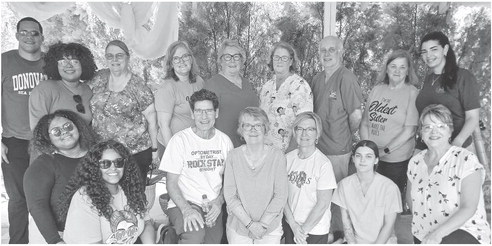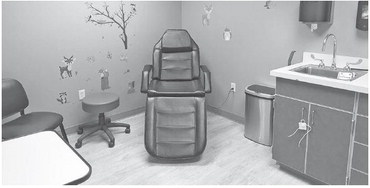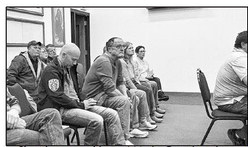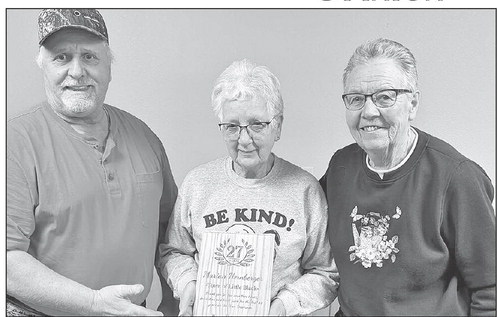Sharing the gift of sight with those in need


There are few gifts greater than giving people the ability to see more clearly.
Two area women recently traveled to the Dominican Republic as part of a recent mission trip to share that gift of sight.
Betty Herrell and Diane Solberg of HealthView Eye Care Center in Medford and Colby took part in a mission trip with Volunteer Optometric Services to Humanity (VOSH) to the Dominican Republic January 11 to 20. This was Herrell’s fourth trip as part of the program and Solberg’s second.
They flew into Santo Domingo, the capital of the Dominican Republic and then had a six-hour bus ride along the southern half of the country to reach the Province of Elias Pina one of 32 provinces in the tropical Caribbean nation. The temperatures while they were there on the mission trip ranged from 85 to 92 degrees. The area is on the border with Haiti and is among the poorest of See VOSH on page 5 the region of the Dominican Republic. The Dominican Republic and Haiti share the island of Hispaniola. The primary language in the region is Spanish.
The province measures about 550 square miles and in 2014 had a population of about 85,000 people. There are six municipalities in the province and they are represented in the government by one senator and two deputies.
The province’s capital is Comendador, which is where Herrell and Solberg spent the majority of their time seeing patients. The city has a population of about 44,000 people, or a little more than half of the residents of the entire province.
Solberg noted there is very little in the way of development with agriculture being the primary occupation. The average monthly income in the region as of 2020 was $120. Even by Dominican Republic standards this is far lower than average. The average monthly income for the rest of the Dominican Republic is about $800 per month.
In addition to agriculture, the area, especially around Comendador, relies on trade with Haiti to keep the economy going. The major crops are coffee and beans in the mountain areas and potatoes in the southern area.
The 2024 VOSH team included 2 optometrists, 1 dentist and 8 people on the para team divided between six opticians and two dental assistants.
Over the time they were there, there were 1,444 eye exams given and more than 2,000 pairs of glasses dispensed. These ranged from basic reading glasses and sunglasses to high-powered prescriptions.
Herrell noted the need for sunglasses due to the almost constant tropical sunshine, the high prevalence of conditions that are related to overexposure to sunlight and harmful ultraviolet radiation. The patients’ ages ranged from three months to 113 years.
In addition to the vision team working to improve eyesight the dental team was on hand to do exams on children to adult with most services being extractions and fillings.
Herrell explained that people would line up and wait to be seen, often coming in their nicest clothing and were very appreciative of the services they were able to get.
Both women are paraoptometric assistants with HealthView, together they have collectively worked for HealthView Eye Care Centers for over 65 years.
“We are both passionate about providing eye health care to patients in our community and this is an opportunity for us to expand that care to others so much less fortunate,” Solberg stated.
While on the trip, they stayed right in hotels in the downtown area next to where the clinics were held.
“We were right in the middle of it,” Solberg said, noting their rooms were above a bus station.
They explained that being a border community, there was a lot of traffic from Haiti.
“It was more eye opening of the real life and the poverty of the people of that region compared to last year,” Solberg said. She noted that they were exposed to seeing more of real life - both good and bad.
In addition to seeing many farmers, there were also professionals, members of the local military, hospital workers and a number of teachers.
Patients coming to the clinic first are tested using a camera device which measures their rough prescription needs. The optometrist then gives a finer prescription and checks for other eye health concerns such as cataracts or glaucoma.
It was then Solberg and Herrell’s job to try and find a match for the prescription from among the donated glasses that were brought by group members to the mission trip. The eyeglasses are collected by the Lions Clubs of Wisconsin which has drives to collect used eyeglasses. The Lions sort and label the glasses and have them ready for the group members to take. Each of the people on the VOSH team travels with luggage containing about 300 pairs of glasses. They transport the equipment, needed supplies, and glasses for the mission as part of their own luggage. This can cause the extra bag fees charged for airline passengers to greatly add up, Solberg noted.
Because they are working with donated glasses, it is hard to find prescriptions that fully match what is needed. Often they are trying to find the ones that are closest to the prescription.
Solberg gave the example of a patient who was about 40 years old and was so near-sighted that she had trouble seeing the large E at the top of the eye charts. Solberg said she was able to match her with a prescription and placed them on the woman’s face.
“Her eyes lit up and she threw her arms into the air and started clapping and I got a big hug,” Solberg said.
After giving the glasses, they have an eye chart on the wall for people to check their vision with them. Herrell said one patient waved away the eye chart and instead pulled a Bible out of her purse. “Her and I read John 3:16 out of her bible,” she said.
“It was just a really sweet, sweet moment,” Herrell said.
As a volunteer mission, each of the attendees pays their own way and takes vacation time from their work to go on these humanitarian trips. Some of the individual expenses include airfare, the costs incurred to travel with extra luggage, as well as travel expense’s lodging and meals while in the Dominican.
Solberg and Herrell noted the 2024 VOSH Mission Trip expenses were partially supported by Healthveiw Eye Care Centers and Area Lions Clubs in Taylor and Clark Counties.
“A huge thank you to them for their support,” the women said.
Herrell and Solberg said as much as they were able to do in their time there, there remains significant need for glasses throughout the underdeveloped world. They encourage people to donate their used pairs of glasses to Lions members so that they may be put to use bringing the gift of sight to people in need. They also encourage people to donate nonprescription sunglasses and reading glasses which are also in high demand.







